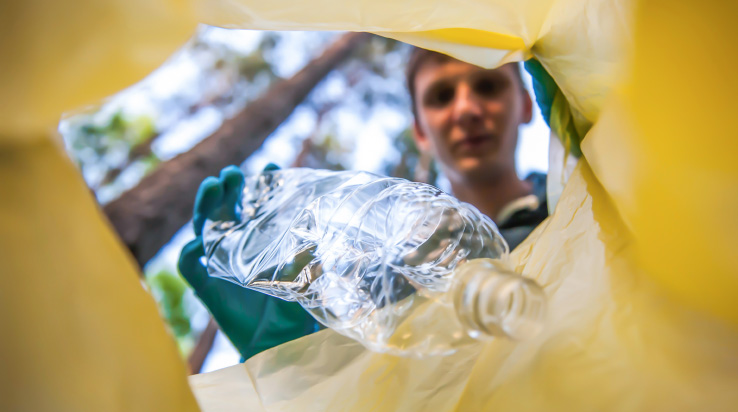
In 2018, Greta Thunberg delivered a speech at the UN, urging the world to make positive climate change. In that same year, the then Education Secretary Damian Hinds challenged schools in the UK to end their use of single-use plastics by 2022.
We were reminded of this recently when the #onlyoneearth campaign launched for World Environment Day. While the government set ambitious targets, schools and charities feel that they were left to implement the strategy without actionable support. Despite the best efforts of schools, charities and businesses, Hinds’ objective is still far from being achieved.
Working with multi-academy trusts, we have seen how leaders are acting to reduce the environmental impact of their schools, and not just in relation to plastic use.
Steering school buying behaviour towards sustainability
Helen Burge, deputy COO of The Priory Trust, has outlined what a whole-school sustainability approach means for schools. As a key contributor to the sustainability strategy published by the Department for Education earlier this year, she gave us some great insight into how a desire to be more sustainable can change schools' buying behaviour.
“You can expect that there aren’t green experts in our schools…however the DfE do want schools to have a sustainability lead, and it is unclear whether [they] come from an education background, governance or from an operational background. I would argue that all three need to be involved. That will really bring about the culture change that we need to embed within all our schools.”
Helen Burge, Deputy COO, The Priory Trust

The DfE strategy sets out five action areas which will drive the strategy. They are climate education, green skills and careers, the education estate and digital infrastructure, operations and supply chains and international.
However, Helen argues that while the five action areas are important, the time has come for taking actions that have an impact now. “I would argue that as adults, as leaders in organisations right now, we need to be doing that. We can’t simply train the next generation to solve the problem, we need to be solving the problem now.”
Senior leadership teams need to understand what they can do. By reviewing their own supply chain, and by procuring responsibly, it is possible to get closer to the government’s targets.
What can you do as a school or trust?
-
Review procurement frameworks
Using a procurement framework that offers sustainable goods and services is a good place to start. By examining suppliers through a ‘green lens’, school leaders can procure quality assured, accredited and sustainable products to ensure they uphold their sustainable pledges. Not to mention, all providers on a framework are subject to stringent due diligence.
Outsourcing IT services or moving to cloud-based systems may seem like an outsourcing of carbon impacts. However, this approach does mean that schools take advantage of the significant efforts of the main providers to reduce their environmental impact. The cloud storage and computing resources of large data centres are managed very closely to optimise energy use and security.
-
Avoid making hasty purchases
Companies such as Amazon may offer a quick fix when you need something urgently. But without reviewing the root causes that resulted in the urgent problem, you are likely to run into the same issues again. Consider too, having fewer shipments of your textbooks. This relies on you having storage in the school, and the ability to have true stock management, with call-off contracts to draw down your orders.
-
Waste management is crucial
If you purchase throughout the year, you can often be left with outdated devices, wiring and power supplies that need to be disposed of routinely and responsibly. Often this comes at a cost. Your suppliers should adopt a circular economy approach. This can include advice and options for free take back, so the items can be reused, repaired or recycled through a circular economy approach.
In addition, your suppliers should be looking across their full range of products to support a circular economy, by reducing reliance on single use materials and items or minimising packaging wastes.
“Schools will be looking to companies for guidance and support on how they can recycle, repair, or manage the waste stream for products that they buy”.
Helen Burge, Deputy COO, The Priory Trust
-
Beware of greenwashing
Suppliers and businesses are generally keen to talk about their carbon reduction efforts. Often these are promises to offset their emissions by planting trees in another location to tackle deforestation. Whilst this is a reasonable activity, it is not a holistic approach to sustainability. An end-to-end environmental strategy is crucial; who supplies your supplier, are digital solutions preferred, will moving to the cloud really take you to net zero?
-
Think about an audit
Audits can be laborious and time consuming. But even something as simple as a print audit can reveal valuable opportunities to reduce your footprint. Reviewing the use of printers and multi-functional devices, can uncover high energy consumption from underused devices. This can have a notable effect on network performance and energy consumption, especially if older devices are being left on overnight or during holidays.
-
Develop a long-term strategic plan
If you’re familiar with Information Technology Infrastructure Library (ITIL) terminology, you’ll have heard the phrase ‘Start where you are’. With the exceptions of some Eco and Free Schools, there is little benefit in attempting to start completely anew.
We have worked in education for almost 50 years. From some of the UK’s largest multi-academy trusts, to single site primary schools, we have learnt that a staged multi-year plan for any strategic improvement is the safest, most cost-effective way of delivering real value to students and staff.

Will it make a real difference?
Returning to Mr. Hinds’ vision of making one single change, there is a risk of being too focused on one activity. Small changes might be valuable with the right guidance. But it does not consider a holistic approach to sustainability.
Whilst we educate the next generation, the responsibility still falls into the hands of adults to deliver the change necessary to give the next generation the best chance to make a difference.